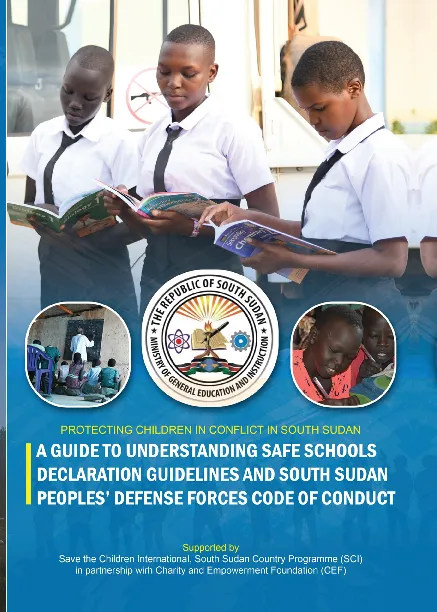
Manuals, Toolkits and Guidance
A Guide to Understanding Safe Schools Declaration Guideline and South Sudan Peoples’ Defense Forces Code of Conduct
Publication year:
2022
English
Format:
PDF (9.9 MiB)
Publisher:
CEF, Charity and Empowerment Foundation,Global Education Cluster,Republic of South Sudan Ministry of General Education and Instructions,Save the Children International
The attacks on education occurred in South Sudan throughout and across the country resulting in the damaging of schools and killing and injuring students and teachers. More than 150 schools were used for military purposes and hundreds of children were abducted from their classrooms since the start of war in 2013. In December 2017 alone, UNICEF reported that around 2 million children in South Sudan were out of school, representing 72 percent of the country’s school-age population. This was the largest percentage of any nation’s children out of school at the time. Schools across the country were frequently closed due to fighting and the threat of violence, and hundreds of schools and other civilian assets were looted and destroyed. Since the beginning of the conflict in December 2013 to date, 293 incidents of attacks on schools or protected persons or of military use of schools were reported across the country. These incidents cumulatively affected more than 90,000 children. Most parents kept their girls home from school to do housework, with conflict and famine adding fuel to their decisions.
In June 2015, South Sudan took a momentous step as one of the first governments
to endorse the Safe Schools Declaration. The Safe Schools Declaration is an inter-governmental political commitment and agreement that outlines a set of commitments to strengthen the protection of education from attack and restrict the use of schools and other learning institutions.
The purpose of the Safe Schools Declaration is to protect students, teachers, schools, and other learning institutions from some of the worst effects of armed conflicts The Declaration offers guidance on concrete measures that armed forces and non-state actors can take to avoid military use of educational facilities, to reduce the risks of attacks, and to mitigate the impact of attacks and military use when they occur.
Read full abstract
View & Download
Document information
Publisher
Format
Content type
Country
Region
Rights
© Author/Publisher
Found a mistake? Help us improve!
If you have noticed a document assigned to the wrong author or any other inaccuracies, let us know! Your feedback helps us keep our data accurate and useful for everyone.
Share
Link
